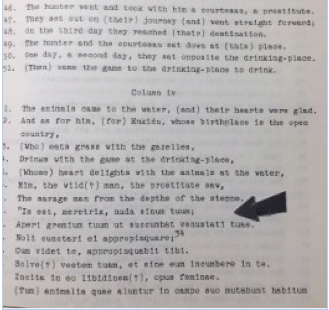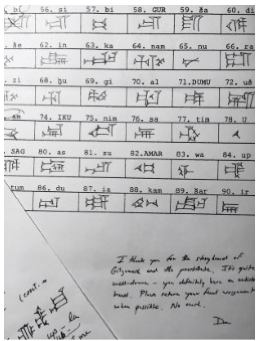Text by Kent H. Dixon
Illustrated by Kevin H. Dixon
The most complete Gilgamesh in translation--including the new discoveries from tablet V.
The Epic of Gilgamesh is the Ur-epic—the hero's journey, quest, and education—inscribed onto damp clay tablets several millennia before Odysseus or the priest of Ecclesiastes found their voices. Sumerian versions of the epic date back almost 5000 years. It is a Bildungsroman of a bad king learning to become a proper human being and therefore a wise king, and to do so, besides defeating lions and monsters and surviving great physical and emotional suffering, he must face, and answer, the first (and last) great question: mortality.
Translated into English and presented here in its entirety as a graphic novel, this version of The Epic of Gilgamesh is a father/son project by scholar and translator Kent H. Dixon and his son, the comix artist Kevin Dixon, who bring a fresh take on this great work. The reader is slowed down by the artwork and visual jokes and the artist's wry hat-tippings to various masters (Crumb and Gilbert Shelton alongside Schultz and Capp, Popeye and Krazy Kat, Uderzo's Astérix and Hergé's Tintin), and then, once the reading pace has shifted into lower gear, having all these aspects complementarily drawn out, makes for an especially satisfying counterpoint to the low-key, the wise and cynical and morally sophisticated, and sometimes sublimely Olympian humor.
The Making of the Dixon Gilgamesh
You have to read this story. It’s the Ur epic—the Road Trip, Hero’s Adventure, bromance and home-coming all in one. In fact, there are several books out there delineating tropes and characters in the Gilgamesh that recur in Homer’s epics. And if Homer, well, then on to Ovid, Virgil, Dante, Spenser, Milton, and epic epic epic down to us—whether a Joycean Ulysses or a Coppola Apocalypse Now.
This story is not just in our blood, it’s in our marrow: it makes our blood. The Old Testament lifts actual lines from it. I’ll show you one place, in Ecclesiastes, a little later. Not to mention the Flood Story: not even Noah is that old. (I mean, the chosen patriarch and his family, and the animals two by two, the flood, the exploratory raven and doves, even the dimensions of the ark, occur in a Sumerian version of Gilgamesh over two thousand years before they do in Genesis.) [This pre-publication of the Bible’s exact words (more or less) played holy hell with the faithful in 1872 when it was first translated—God plagiarizing?!—but that’s another story. Maybe later.]
Elsewhere in this website, and in Kevin’s and my new (May 22, 2018) graphic novel of the Gilgamesh, I talk about how I came around to try a ‘translation’ of it. Maybe most cogently if not so succinctly in my Translator’s Note herein, which is a little academic but nicely balanced by Kevin’s Artist Statement—detailing a few of his tribulations with the artistic end of things.
Very briefly, I was teaching Gilgamesh along with Homer and Euripides &c., but I could never settle on a right translation of it. They’re either too wild and more about the translator than the translation, or the good ones, by terrific scholars, are so cluttered up with notes and half-readings and alternate readings that it’s the visual equivalent of singing an aria with severe heart burn.
So one day Dr. Dum-dum asked himself, What would he want? And so I did the first tablet, and saw that it was good, or at least a lot of fun, and a justifiable escape from grading papers. It went on from there, ever s o s l o w l y.
Somewhere I have a picture of about 20 translations and renditions spread out on the floor of my office and over  every surface, with a foot holding one of them open and a finger on another on my desk, like a Rosemary Woods 18 ½ minute stretch, but, alas, can’t find it. But that was the routine: a dozen or so of the best translations laid out, and me taking a line or two at a time, memorizing its content, writing out what I then saw, and then enhancing my rough by selecting pieces of the best rendering of that same content—a word here, an idea there—from among the sundry choices, weeding them as I went of all their explicit if impressively meticulous scholarship.
every surface, with a foot holding one of them open and a finger on another on my desk, like a Rosemary Woods 18 ½ minute stretch, but, alas, can’t find it. But that was the routine: a dozen or so of the best translations laid out, and me taking a line or two at a time, memorizing its content, writing out what I then saw, and then enhancing my rough by selecting pieces of the best rendering of that same content—a word here, an idea there—from among the sundry choices, weeding them as I went of all their explicit if impressively meticulous scholarship.
And when dissatisfied or in doubt, or if they were in doubt, then I’d track down more translations, in other languages even. I set my parameters wide: anything that anyone had written, however far afield from my Heidel baseline (above), was fair game. Is est, meretrix, nuda sinum tuum
Why Heidel?
Alexander Heidel’s 1946 translation is dull and cautious and sometimes outright prudish—he renders the sex scenes (above) only into Latin! — but the English is, as far as I can tell, just about word-for-word with the original Akkadian. It is literal, or very close.
Every time I’d cobble more than two words together directly from the original—(I did get as advanced as noun phrases, plus one whole speech by the epic’s best philosopher)—I’d check them against Heidel’s and sure enough, that’s what was pretty much clunkily there. So with him at the center, I fanned out to everybody else, no matter how far off: their guesses and inventions were fair game. I didn’t abuse that ‘rule’ but it gave me the freedom to make many of the tough choices.
Like, just what are the “magic stone things” that Gilgamesh destroys at the river bank? Kevin came up with the  idea of the pulley system. That covered a lot of translators’ angles on that infuriatingly elusive passage, which gets translated as everything from gods disguised as walking talking stones, to crumbling bridges, to Urni snakes, to Stone Charms to counter-weights or anchors or ballast for the boat. Lots of guesswork, all around. A Hittite version has them as merely ‘images,’ perhaps amulets to ward off contact with the instantly-fatal waters of death.
idea of the pulley system. That covered a lot of translators’ angles on that infuriatingly elusive passage, which gets translated as everything from gods disguised as walking talking stones, to crumbling bridges, to Urni snakes, to Stone Charms to counter-weights or anchors or ballast for the boat. Lots of guesswork, all around. A Hittite version has them as merely ‘images,’ perhaps amulets to ward off contact with the instantly-fatal waters of death.
Now all this sort of thing constitutes a rendition, not a translation. I can’t read Akkadian, in the cuneiform script, except… given a single word or phrase, and the better part of an afternoon in the OSU or Univ. of Chicago library, with the 26 volume CAD dictionary, I could read it—one word at a time. I took a “Cuneiform by Mail” course from an Assyriologist at the Oriental Institute, University of Chicago, & learned to read around a 150 of the most common characters (out of a syllabary totaling 600 to 800 characters). Picture below is from some of my homework. (Note the teacher’s note at bottom!)
An aside: Somewhere else in here or in an interview in OPEN : Journal of Art and Literature, I describe what happened to my brain when I wedged this screwy ‘alphabet’ into it: it became a kind of monster of memory: I was able to direct my memory to childhood and on, and recall things that had totally evaporated. Memory as bicep: exercised with 20# barbell three times a day, 20 reps. Sha naq-ba i-mu-ru lu-se-id-di ma-a-ti/ [sha kul-la-ti]i i-du-uka-la-[ma-sal-m]i-s[u] . . .
There’s a lesson for all of us in that, I’ll tell you. Do those cross-word puzzles!
Take up that new language, get a part in a play, learn a musical instrument. Use it or lose it. Not only can you recall long-forgotten snatches of your life, piecemeal, you can sometimes—or I found myself able to—remember what came before and after those clips. That blackness around a fond memory has always haunted me. I was able to shine a light into it, and even around its edges, when I was wrestling with the likes of this stuff: 
It's not an alphabet, per se. Those symbols represent what we call syllables. It's as if you had a huge list of hundreds of word parts: re-, -cede, pro-, -tion, inter-, -fere, tuli, latus, some seven or eight hundred of mostly mono-syllables listed in what’s called a ‘syllabary.’ Sometimes a character can represent a whole short word—a logograph. And there are plenty of pictographs, which are fun because they probably enact how we got to alphabetic characters in the first place. Like the ‘dinger,’ which is the second character in the picture above, which is used to indicate that a proper noun is the next word—it’s like capitalizing a letter—a direction, not a sound—and is a streamlined version of its earliest Sumerian self, which was a picture of sun and its rays:

You get the idea. I’ll look for one:
Here, the asterisk- - - - - - - - - - - - - - - - - - - - - - - - - - - - - - - - - - - - - - - - - - - - - - - - - - - - - - > 
So * or “sun” = god or other important name, alerting a reader that the next string of characters is a proper noun—name of a God, or River, or City, or King or personal name like Enkidu or monster like Humbaba.
And when I say ‘string,’ I mean like an endless noodle. There’s no punctuation, there’s no division between words. There is grammar, syntax of sorts, which remained pretty much outside my ken.
But the point I lost here is, with this mess of syllables and short words and stylized pictures, you sort of have to know them to read them; that is, to combine and recombine them to get to different words. You can’t really sound them out, like a kid’s halting kuh – aa – tuh, CAT! The scribes began training as children and spent their entire lives learning and refining these symbols, as well as impressing into damp clay an immense amount of verbiage, most of it practical & legal, though some in fun (parodies), and some, like Gil, really great art. Somewhere I’ve read that there is more untranslated Akkadian and Hittite and Sumerian and Urartian, et al., on tablets and fragments, than there is of all translated classical literature—Greek and Roman. I don’t see how that’s possible, but I did read it somewhere and it’s sometimes fun to imagine believing everything you read, is it not? Brave old world, that hath such lunatics in it.
Read the full essay here.



